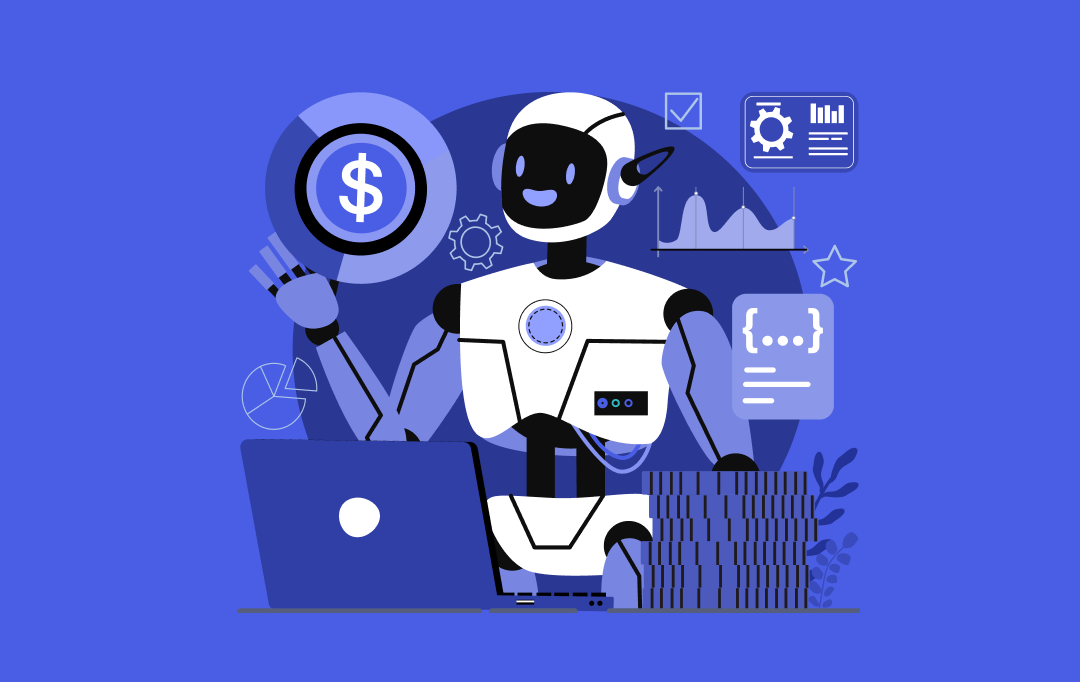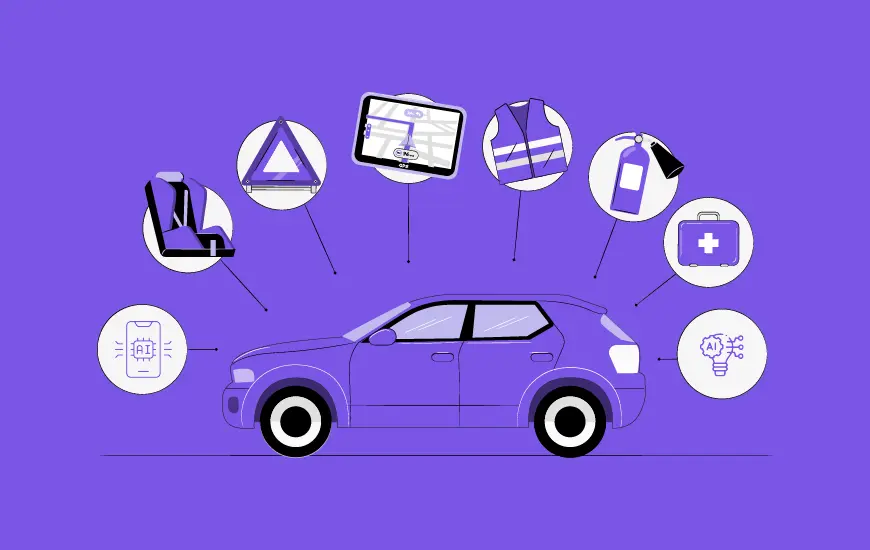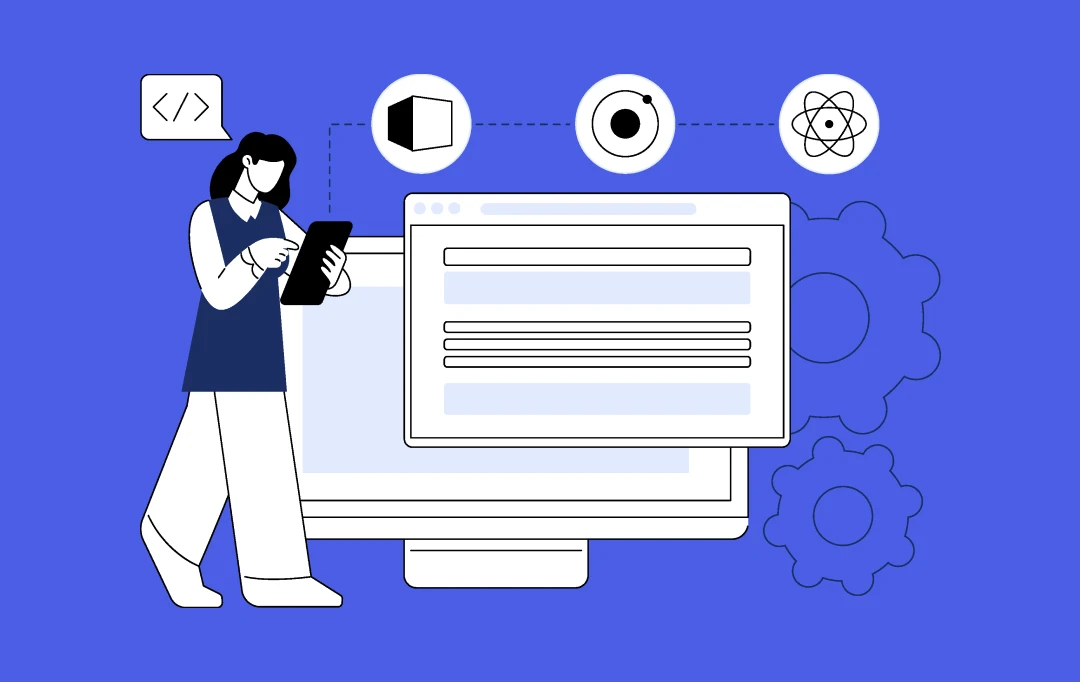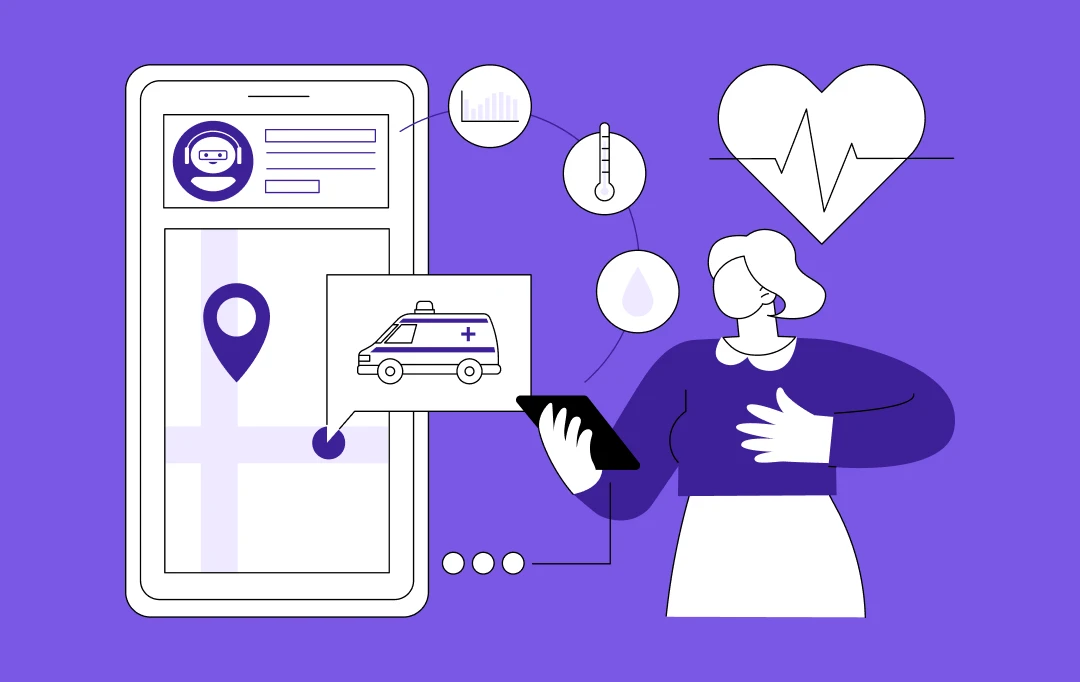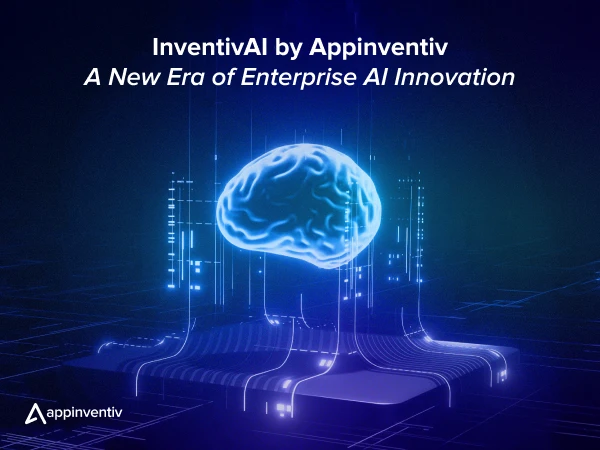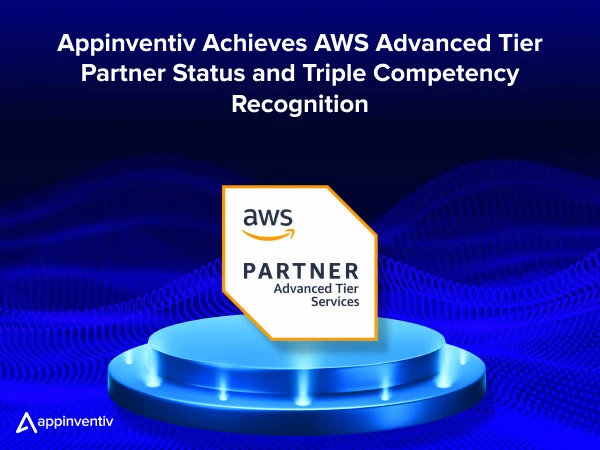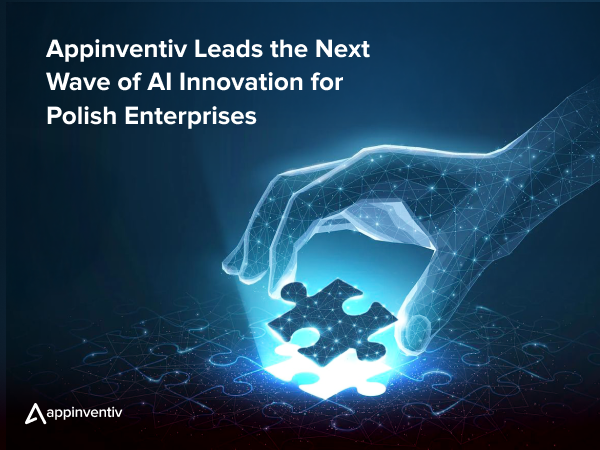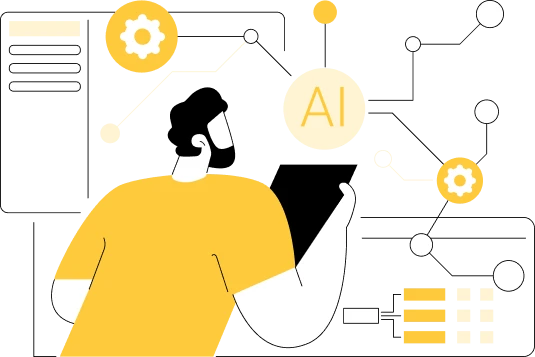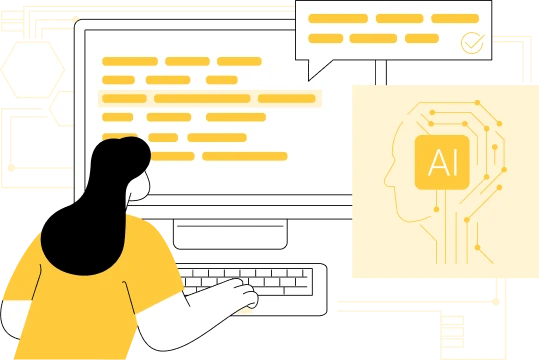- The Unprecedented Growth of the Global AI Market
- Understanding the Working Principles of the Intelligent AI Model
- How the Five-Layer Model Optimizes Enterprise AI Systems
- Infrastructure Layer
- Data Layer
- Service Layer
- Model Layer
- Application Layer
- How to Make an AI Model - A Step-by-Step Process
- 1. Identify the Issue and Goals
- 2. Gather and Prepare Data
- 3. Choose the Correct Algorithm
- 4. Design for Model Architecture
- 5. Train, Validate, and Test the Data
- 6. Train the AI Model
- 7. Fine-Tune the Hyperparameter
- 8. Do Model Assessment
- 9. Test and Deploy the AI Model
- 10. Evaluate and Improve the Model Performance
- How to Build Generative AI Models?
- Clearly Define Your Objectives
- Collect and Prepare Data
- Train Your Gen AI Model
- Deploy the Gen AI Model
- Frameworks and Tools to Develop an Intelligent AI Model
- Model Development and Training Tools
- Big Data and Processing Tools
- Visualization & Workflow Tools
- Challenges Associated with AI Model Development for Enterprises and Strategies to Overcome Them
- Data Security and Privacy
- Transparent Data Handling
- Regulatory Compliance
- Integration Difficulties
- Data Quality and Quantity
- Infrastructure Scalability and Flexibility
- Generative AI Development and Implementation
- AI Model Development Mistakes and How to Avoid Them
- Misaligned Business Goals
- Poor Data Quality
- Overfitting/Underfitting
- Ignoring Ethical Considerations
- Insufficient Testing and Validation
- Inadequate Model Explainability
- Lack of Model Monitoring
- Cost of AI Model Development
- Future of Custom AI Model Development: What's Next in the AI Age
- AI on the Edge: Smarter, Faster Decisions
- AI Taking the Reins: Autonomous Systems
- Demystifying AI: Explainable AI (XAI)
- AI for a Greener Planet: Sustainability Focus
- Build AI Models With Appinventiv & Fly High in the Digital Sky
- FAQs
- Q. What is the impact of AI on enterprises?
- Q. How does an intelligent AI model work for enterprises?
- Q. How to create your own AI models?
- Q. How do enterprises build intelligent AI systems?
- Q. What are the best tools and platforms for developing AI models at an enterprise level?
- Q. What is the AI model development process for businesses?
- Q. What are some common types of AI models?
Key takeaways:
- AI model development for enterprises is indispensable in today’s AI era. Before building, clearly define the problem and goals for your AI model.
- High-quality, well-prepared data is paramount. This involves collecting, cleaning, preprocessing, and labeling data, which directly impacts the model’s effectiveness.
- Building an AI model is a multi-step process involving careful selection of algorithms, architecture design, rigorous training, validation, testing, and fine-tuning.
- Deployment isn’t the end; continuous monitoring, evaluation, and improvement are essential for maintaining model performance and adapting to new data and feedback.
- AI development costs typically range from $40,000 to $400,000, depending on the model’s complexity, data needs, chosen tools, etc.
“AI saves lives.”
When 40-year-old Lauren Bannon turned to ChatGPT after multiple misdiagnoses, she sought answers. What she found was life-changing. The AI suggested a condition her doctors had overlooked—”Hashimoto’s disease”—which eventually led to the early detection of two cancerous lumps. That moment didn’t just save her life; it spotlighted the extraordinary potential of AI in mimicking human intelligence and transforming lives.
Stories show how far AI has come in healthcare and across other industries, including financial predictions in BFSI and autonomous driving in the automotive sector. While it can’t replace experts, it certainly offers critical insights, enables discoveries, supports real-world decision-making, and sometimes even saves lives.
Who would have thought that technologies could perform complex tasks with such precision and perfection a decade ago? But today it has become a reality. As a result, custom AI model development for enterprises has become essential to meet the demands of the modern world.
This blog will walk you through how to build an AI model for enterprises. By examining the confluence of cutting-edge technology and strategic intelligence, we will explore the process, complexities, and costs of creating AI models that enable enterprises to foster innovation and remain ahead in a data-centric environment.
Important Note: Building production-ready AI models typically requires 6-18 months of development time and approx $40,000 to $400,000 of investment (details later).
Don’t get left behind. Build intelligent, scalable, and future-ready AI models today.
The Unprecedented Growth of the Global AI Market
The increasing reliance on AI technologies is reflected in the growth of the global AI market, which is poised to grow exponentially over the next decade. According to Statista, the market reached over $184 billion in 2024, a jump of nearly $50 billion from the previous year, with projections crossing $826 billion by 2030.

This growth is attributed to the myriad of industries that have already integrated AI into their operational systems. Notable developments include the rise of chatbots, image-generating AI, and other AI-based mobile applications, making the future of artificial intelligence promising.
Within this landscape, generative AI stands out as a rapidly evolving segment. A new era of opportunities began in 2022 with the release of ChatGPT. This marks a pivotal shift in the adoption of generative AI. The transition is visible when analyzing the dramatic rise in the utilization of generative AI from 2022 to 2024.
Gen AI adoption nearly doubled in just two years, from $29 billion in 2022 to $50 billion in 2024. The Gen AI market is expected to exceed the market volume of $442.07 billion by 2031. Companies that moved early are already witnessing clear returns with each penny invested in Gen AI development.
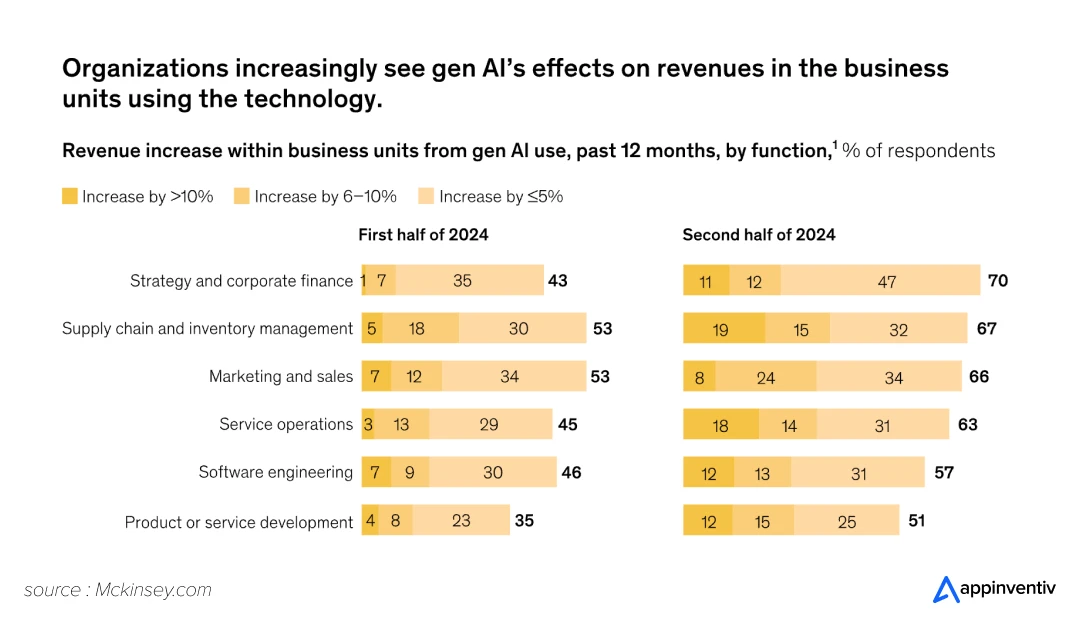
This momentum will continue as users seek more sophisticated, human-like chatbot experiences. Upcoming iterations of ChatGPT and similar AI models will likely fuel this trend even further.
Related Article: Cost of Developing a Chatbot like ChatGPT
Understanding the Working Principles of the Intelligent AI Model
Intelligent AI models are designed with a high level of cognitive capacities and the ability to carry out challenging tasks with comprehension and judgment comparable to human intelligence. These models are created with complex algorithms and deep learning strategies, frequently incorporating neural networks, enabling them to process enormous volumes of data, recognize patterns, and anticipate or take actions based on the input given.
An intelligent AI application or model is characterized by its ability to learn, reason, understand, adapt, interact, solve problems, and generate accurate results.
At the core of their work lies a multi-stage process: data collection, training, inference, and continuous learning. Intelligent AI models begin by consuming large datasets to identify meaningful patterns. These patterns are processed through layers of neural networks that mimic the human brain’s functioning, enabling the model to learn correlations, make decisions, and refine outputs based on feedback. This adaptive learning loop improves the model over time, delivering more accurate predictions and human-like interactions.
Critical Insight: Based on our implementations, models typically require 3-6 months of continuous monitoring and adjustment post-deployment to achieve optimal performance in production environments.
Remember, “AI models are like children; they learn from what they see. If we don’t curate their environment carefully, they will absorb the worst of our world.”
For instance, a large language model like ChatGPT, which can generate human-like text in response to commands and identify objects, people, and scenarios in photos, is one example of an intelligent AI model.
A real-world application of such a model is seen in Appinventiv’s collaboration with JobGet, an AI-powered job search platform. By integrating GPS functionality, our intelligent AI model developers successfully established a mechanism to connect job-seekers with nearby companies actively seeking to hire.
The results were outstanding:
- $52 million in Series B funding secured
- 2 million+ mobile app downloads
- 50,000+ active companies placed on the platform
- 150,000+ job seekers recruited via the app
How the Five-Layer Model Optimizes Enterprise AI Systems
In order to build a cohesive AI system, enterprise AI architecture often comprises multiple layers. The five-layer model is a popular strategy that divides the various parts of an AI system into distinct levels, each with its own function. The five-layer enterprise AI architecture paradigm is described in the following way:

Infrastructure Layer
The infrastructure layer offers the computing power needed for data processing and analysis. This layer consists of hardware resources that speed up AI computations, including servers, GPUs (Graphics Processing Units), and other specialized tools. Enterprises can choose from scalable and adaptable infrastructure alternatives on cloud platforms like AWS, Azure, and Google Cloud.
Data Layer
Data is the cornerstone of any AI system. Data is collected, stored, and preprocessed in the data layer. Tasks, including data cleansing, transformation, standardization, and enhancement, fall under this layer. High-quality, well-organized data is necessary to develop accurate and efficient AI models. Businesses frequently utilize data lakes or warehouses to store and manage massive data.
Common Data Challenges We Encounter in AI Model Deployment in Enterprises
- Inconsistent data formats across 15-20 different source systems
- Missing values in 25-40% of historical datasets
- Data drift occurs every 3-6 months in production environments
- Regulatory compliance requirements (GDPR, CCPA, HIPAA) affect data usage
Service Layer
The service layer is concerned with servicing and deploying intelligent AI models to applications, services, or end users. This layer entails developing APIs (Application Programming Interfaces), enabling communication between systems and AI models. It involves activities including scaling, monitoring, and model deployment. Architectures with microservices and containers are frequently utilized to speed up deployment and management.
Production Considerations:
- API rate limiting: 1000 requests per minute per client
- Load balancing across 3-5 model instances
- Failover mechanisms with 99.9% uptime guarantees
- Security protocols, including OAuth 2.0 and JWT tokens
Model Layer
The actual AI models are created and trained at this layer. In this layer, relevant algorithms are chosen, neural network designs are crafted, hyperparameters are tuned, and models are trained using labeled data. Constructing and training AI models on this layer is a common practice using machine learning frameworks like TensorFlow and PyTorch.
Application Layer
The AI capabilities are linked to business apps and procedures at the application layer. This layer includes creating apps that use the predictions and suggestions made by the AI models and incorporating AI insights into decision-making processes. These apps can be used in many fields, such as fraud prevention, supply chain optimization, and customer service.
How to Make an AI Model – A Step-by-Step Process
Building an AI model might sound like a complex chore, but it all starts with the right approach. Based on our experience in delivering 3000+ successful enterprise projects, we have refined this process to include critical checkpoints and validation Steps to build AI models for business that prevent costly mistakes. Wondering how AI models are created? Well, here is a step-by-step process for building an AI model that serves your goals and addresses your enterprise’s challenges.

1. Identify the Issue and Goals
Start by outlining the issue that the AI model will attempt to tackle. Identify the goals and outcomes you plan to achieve, along with listing the challenges. This clarity will direct your model-building efforts, guaranteeing the fulfillment of your business goals. Not sure how to do it right? Collaborate with a dedicated IT consulting services firm, and they will help you complete the process with strategic guidance. Even with a well-defined AI model development process, enterprises must navigate common barriers to AI implementation to ensure their artificial intelligence initiatives deliver measurable business value.
Critical Questions to Answer:
- What specific business problem will AI solve?
- What are the success metrics and KPIs?
- What is the expected ROI timeline?
- What are the regulatory and compliance requirements?
- Who are the end users, and what are their technical capabilities?
2. Gather and Prepare Data
Data is the foundation of artificial intelligence model development. To ensure practical effectiveness, the model must be tested in real-world scenarios, making it essential to choose datasets that appropriately reflect those scenarios.
Before training begins, the data should undergo careful cleaning and preprocessing operations. This will help remove any inconsistencies from the data before use. Additionally, thorough data labeling and management are critical to ensure the model learns effectively and delivers accurate results.
Data Quality Framework:
- Completeness: Less than 5% missing values
- Consistency: Standardized formats across all sources
- Accuracy: Regular validation against ground truth
- Timeliness: Data freshness requirements (daily, weekly, monthly)
- Relevance: Feature correlation with target variables
3. Choose the Correct Algorithm
Depending on the nature of your challenge, opt for the suitable deep learning algorithm. CNNs are excellent for tasks involving images, RNNs are ideal for functions involving sequence data, such as text and audio, and transformers can manage complicated contextual relationships in data.
Algorithm Selection Matrix:
- Computer Vision: Convolutional Neural Networks (CNNs), Vision Transformers
- Natural Language Processing: Transformers, BERT, GPT variants
- Time Series: LSTM, GRU, Prophet, ARIMA
- Tabular Data: Random Forest, XGBoost, CatBoost
- Recommendation Systems: Collaborative Filtering, Matrix Factorization
Also Read: Transformer vs RNN in NLP: A Comparative Analysis
4. Design for Model Architecture
The next step is to create the model’s architecture. This entails counting the layers, neurons, and connections that make up the neural network. Model architecture has a big impact on how well the model performs. Therefore, try out several configurations to discover the best one.
Architecture Principles:
- Start with simple baseline models
- Use transfer learning when possible (reduces training time by 70%)
- Implement regularization techniques (dropout, weight decay)
- Consider model interpretability requirements
- Plan for model compression and optimization
5. Train, Validate, and Test the Data
Next, your AI developers create three subsets of your dataset for training, validation, and testing. Training data are used to train the model, validation data are used to help fine-tune hyperparameters, and testing data are used to gauge the model’s effectiveness when applied to untested data.
Data Splitting Best Practices:
- Stratified sampling for imbalanced datasets
- Time-based splitting for temporal data
- Cross-validation for small datasets
- Holdout sets for final model evaluation
6. Train the AI Model
Now, your AI developers will move on to input the training data into the model and then use backpropagation to change the internal parameters incrementally. Training typically requires 100-1000 epochs, depending on data complexity and model architecture. Computational resources are needed in this stage, and contemporary AI frameworks like TensorFlow and PyTorch make effective model training possible.
Training Optimization Techniques:
- Learning rate scheduling (reduces training time by 20-30%)
- Early stopping to prevent overfitting
- Gradient clipping for stability
- Mixed precision training for memory efficiency
- Distributed training for large models
7. Fine-Tune the Hyperparameter
At this stage, the team will focus on improving the model’s performance by fine-tuning hyperparameters, including learning rate, batch size, and regularization methods. Experimentation is a key component of this iterative process to balance underfitting and overfitting.
Key Hyperparameters to Optimize:
- Learning rate: 0.001 to 0.1 (most critical parameter)
- Batch size: 16 to 512 (affects memory usage and convergence)
- Dropout rate: 0.1 to 0.5 (prevents overfitting)
- Weight decay: 1e-6 to 1e-3 (regularization)
- Optimizer: Adam, SGD, or AdamW (affects convergence speed)
8. Do Model Assessment
Next, the team uses the validation dataset to evaluate the model’s performance. Measurements, including accuracy, precision, recall, and F1-score, offer information about the model’s effectiveness. They refine the model iteratively using the findings from the evaluation.
Evaluation Framework:
- Classification: Accuracy, Precision, Recall, F1-Score, Confusion Matrix
- Regression: MAE, RMSE, R², MAPE
- Ranking: NDCG, MAP, MRR
- Fairness: Demographic parity, Equalized odds
- Robustness: Adversarial testing, Data drift detection
9. Test and Deploy the AI Model
Lastly, the development team analyzes the model’s performance and effectiveness using the testing dataset, which mimics real-world situations. This step ensures the model is ready for deployment and fulfils the desired performance criteria.
Deployment Checklist:
- Model versioning and artifact management
- A/B testing framework for gradual rollout
- Real-time monitoring and alerting
- Performance benchmarking
- Security scanning and vulnerability assessment
- Compliance validation
Once the model is trained and deployed, its true value comes from integration into a live application, such as an e-commerce platform or a sophisticated AI-powered marketplace app.
10. Evaluate and Improve the Model Performance
In order to react to shifting data patterns and ensure long-term performance, you must continuously monitor and update the AI model. To keep the model accurate, high performing, and relevant, get user feedback, monitor its performance, and make adjustments as necessary.
Monitoring Framework:
- Performance metrics tracking (accuracy, latency, throughput)
- Data drift detection using statistical tests
- Feature importance analysis
- User feedback collection and analysis
- Automated retraining triggers
- Model governance and compliance auditing
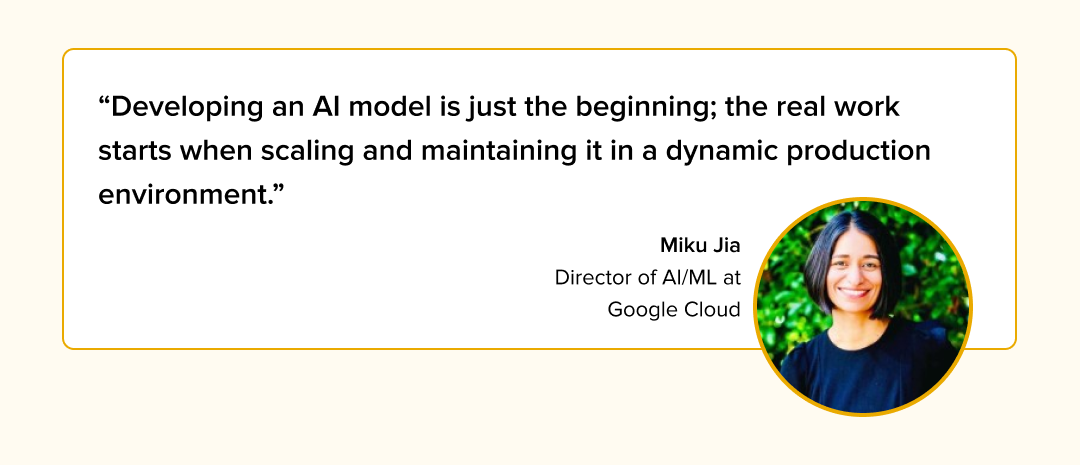
Now that we know how to create an AI model, let us move on to developing a generative AI model. This will ensure that enterprises can go beyond predictive capabilities and create intelligent systems capable of generating content, ideas, and solutions tailored to their evolving business needs and user expectations.
How to Build Generative AI Models?
Building a generative AI model represents a leap into the future of technology, offering transformative potential for businesses. By creating your generative AI model, you can automate and enhance various processes, driving innovation and efficiency across your operations.
If you are wondering how to build your own generative AI model, here are a few critical steps you should follow:
Clearly Define Your Objectives
Setting clear goals is crucial for aligning the model’s capabilities with business needs, whether it’s for generating text, creating images, or innovating in other areas.
Collect and Prepare Data
Collecting and refining high-quality data will be the foundation for training your model. Furthermore, the selection of appropriate algorithms and models is also critical. Depending on your specific goals, choose from advanced options like Generative Adversarial Networks (GANs), Variational Autoencoders (VAEs), or transformer models such as GPT-3.
Train Your Gen AI Model
Training your model requires considerable computational resources. Thus, monitoring the training process closely is vital to ensure the model is learning correctly and able to make adjustments as necessary.
Deploy the Gen AI Model
Upon successful validation, integrate the model into your operational framework where it can begin to deliver value by automating processes, enhancing creative capabilities, and improving decision-making.
Now that you understand how to develop AI models, let’s examine the multiple tools and frameworks required to develop a robust one.
Frameworks and Tools to Develop an Intelligent AI Model
To develop an intelligent AI model, businesses require the right set of tools and frameworks tailored to their goals, team structure, and use case complexity. Here is a categorized overview of essential tools, followed by comparison tables. This will help you choose the right AI tech stack and make informed decisions.
Model Development and Training Tools
These tools are the backbone of AI model creation, which enables training, testing, and deployment. For example, Tesla uses PyTorch for vision-based model training in its autonomous driving stack.
| Tools | Description with Use Case | Pros | Cons |
|---|---|---|---|
| TensorFlow | Google’s open-source library is ideal for building and training ML models, great for deep learning. | Scalable, production-ready, strong community support. | Steeper learning curve for beginners. |
| PyTorch | Facebook’s flexible tool with computation graphs is used widely in NLP and vision tasks. | Easier to debug, more intuitive for research. | Slightly less optimized for production deployment. |
| Keras | High-level neural network API that simplifies experimentation; runs on top of TensorFlow. | User-friendly, fast prototyping, modular. | Less flexible for complex model customization. |
| Scikit-learn | Python library for data mining and machine learning; ideal for classic ML algorithms. | Simple, clean API, great for beginners. | Limited support for deep learning and GPU acceleration. |
Big Data and Processing Tools
These frameworks are ideal when working with large-scale datasets and distributed environments. For example, enterprises widely adopt Anaconda to manage ML environments efficiently.
| Tools | Description with Use Case | Pros | Cons |
|---|---|---|---|
| Apache Spark MLlib | It offers scalable ML algorithms for big data, ideal in distributed computing environments. | Excellent for big data pipelines, fast in-memory processing. | Setup and configuration can be complex. |
| Anaconda | Python distribution with pre-installed ML and data science packages; simplifies environment setup. | Easy environment management | Large installation size, not lightweight. |
| Julia | High-performance language for numerical analysis and modeling; used in computationally intensive tasks. | Faster than Python in many numerical tasks, with easy syntax. | Smaller community, fewer libraries. |
Visualization & Workflow Tools
These tools enhance collaboration, data exploration, and model explainability. For example, data scientists widely use Jupyter Notebooks to document and share model insights interactively.
| Tools | Description with Use Case | Pros | Cons |
|---|---|---|---|
| Plotly | Enables interactive, high-quality visualizations for presenting ML results and insights. | Interactive plots, great web integration. | Advanced features may require a paid version. |
| Git | Version control systems are critical for managing AI codebases and team collaboration. | Essential for collaboration, supports branching and merging. | Steep learning curve for beginners. |
| Jupyter Notebook | Interactive environment for coding, visualizing, and documenting ML workflows. | Combines code and narrative, great for demos and experiments. | Not ideal for large-scale production deployments. |
Expert Advice on AI Tech Stack Selection
- Startups or MVP teams use Keras or Scikit-learn for quick iteration with limited resources.
- Research teams prefer PyTorch for experimentation and flexibility.
- Enterprises choose TensorFlow or Spark MLlib for production-grade systems.
- Beginner teams use AutoML tools like Google AutoML or H2O.ai for low-code implementation.
Also Read: AI TRiSM Framework: Enhancing Trust & Security in AI Systems
Let our AI experts guide you with the right tool selection to suit your project goals.
Challenges Associated with AI Model Development for Enterprises and Strategies to Overcome Them
AI model development for enterprises demands careful consideration to ensure success. Many challenges influence the AI-based intelligent model development life cycle, from data quality to ethical considerations. Let’s look at some of them in detail below and understand how to navigate the complex landscape of the custom AI model development process effectively.
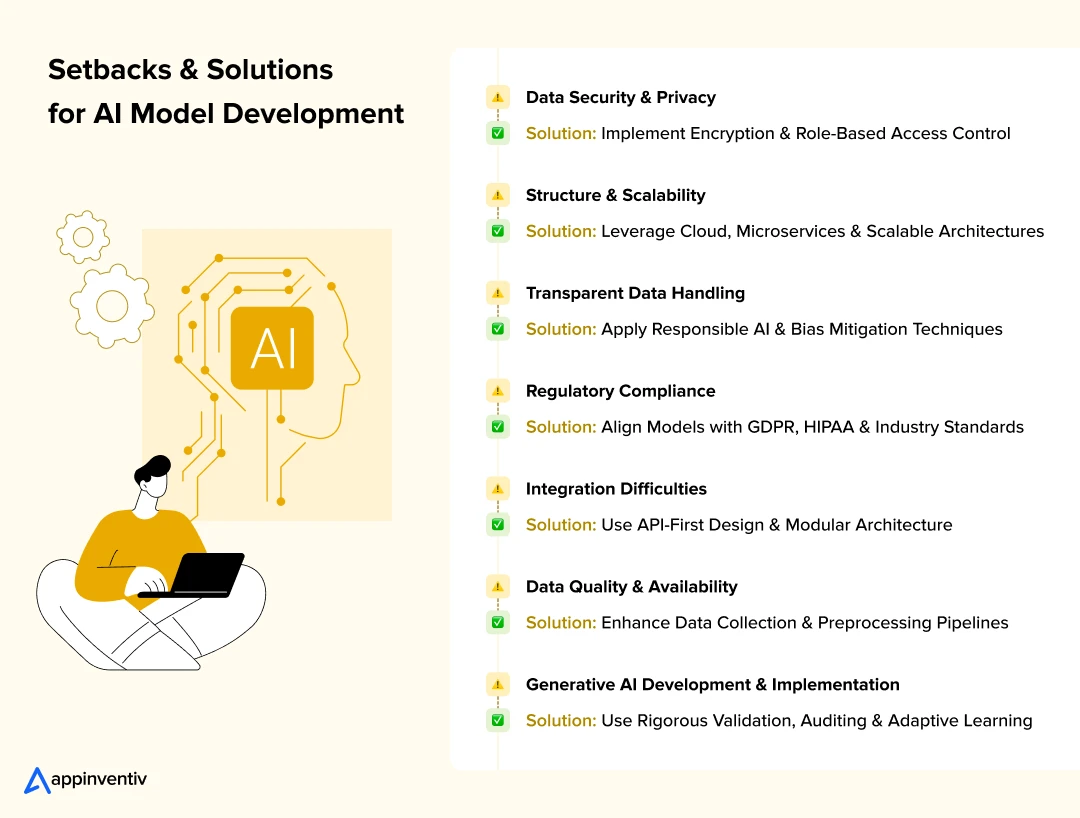
Data Security and Privacy
Challenge: Managing sensitive enterprise data requires robust security measures.
Solution: Implementing strong data encryption and access controls can safeguard sensitive information throughout the development of AI models.
Transparent Data Handling
Challenge: Ethical AI deployment necessitates addressing bias, fairness, and transparency.
Solution: Employ responsible AI techniques to minimize bias in training data and algorithms. This will promote ethical AI practices.
In The Product Experience podcast, Miku Jha, the Director for AI and ML at Google Cloud, emphasizes that responsible AI should be integrated into the foundation of AI-powered intelligent model development from day one, not just as a final checklist item.
Regulatory Compliance
Challenge: Different regulations apply to different industries. This makes it challenging for AI models to comply with diverse legal, ethical, and data protection laws.
Solution: Ensure your AI model conforms to applicable industry standards and data protection laws, such as GDPR, HIPAA, and SOC 2. Integrate compliance checks throughout the AI lifecycle.
Integration Difficulties
Challenge: Integrating AI with legacy enterprise software can be challenging.
Solution: Use modular, API-first architectures and middleware solutions to enable smoother integration with existing workflows and technologies.
Data Quality and Quantity
Challenge: High-quality, substantial datasets are pivotal for effective AI training. However, finding and curating them remains a significant challenge.
Solution: Improve data collection pipelines, apply robust data-cleaning techniques, and invest in data augmentation strategies to enhance model performance.
Infrastructure Scalability and Flexibility
Challenge: Enterprise AI models require high computing power and adaptable systems to support growth and evolving needs. However, designing AI systems that can scale with your business growth is challenging.
Solution: Invest in flexible, cloud-native infrastructure like AWS, Azure, and Google Cloud and adopt microservices architectures to manage training, deployment, and long-term scalability.
Enterprise AI models require high computing power and adaptable systems to support growth and evolving needs, making specialized AI gigafactory infrastructure essential for organizations looking to scale their AI operations without prohibitive capital investments in traditional data centers.
Miku Jia highlighted in her interview that while building an AI model is a milestone, the real complexity lies in scaling and maintaining its effectiveness in dynamic production environments.
Generative AI Development and Implementation
Challenge: Generative AI has become an important trend as AI technology progresses. However, developing generative AI models poses significant challenges due to their complexity and the high level of creativity they require. These models need extensive and diverse datasets to learn effectively and can be prone to biases if not carefully managed.
Solution: To tackle these challenges, it is vital to employ rigorous data validation, regular model auditing, and adaptive learning approaches to mitigate biases and ensure the ethical deployment of generative AI. Using robust computational infrastructure and advanced neural network architectures can also aid in handling the intensive demands of training generative models.
Miku Jia lists four critical factors to successful generative AI deployment: selecting the right platform, leveraging unique data, ensuring enterprise readiness, and establishing responsible AI practices.
Also Read: Key Questions to Ask Before Investing in Custom AI for Business
AI Model Development Mistakes and How to Avoid Them
Developing intelligent AI model development solutions can be complex, and several challenges can derail the process. To ensure your AI project is successful, it is crucial to stay informed about the AI model best practices for businesses and avoid the common mistakes, which are as follows:
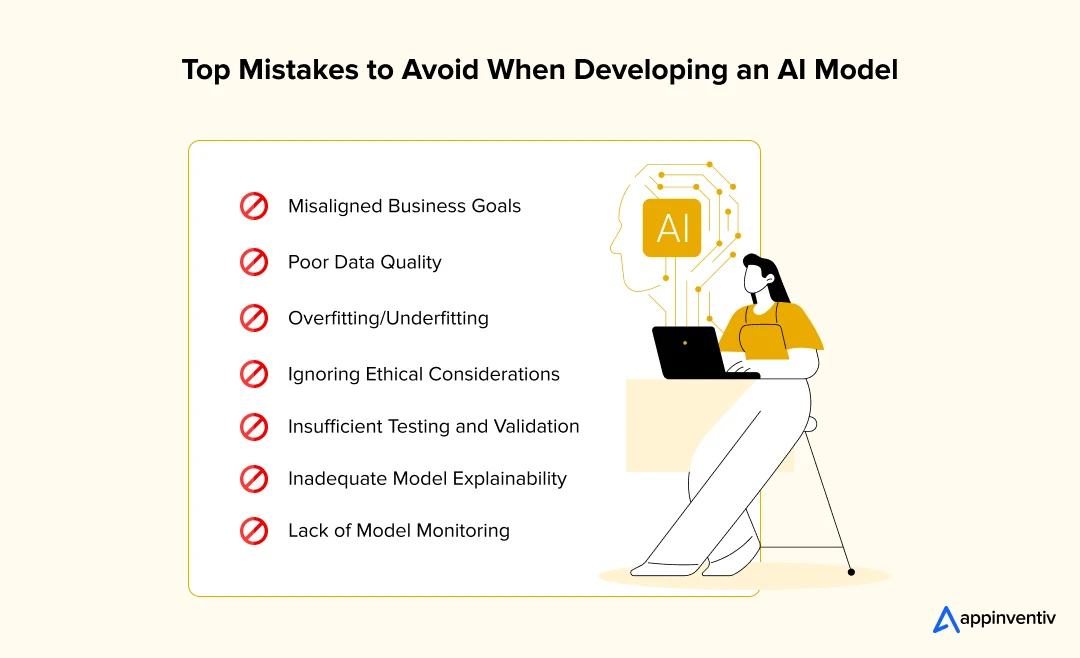
Misaligned Business Goals
AI models must align with your organization’s strategic objectives. Failure to define clear business goals can lead to irrelevant or ineffective models that don’t deliver real value.
Poor Data Quality
Don’t rely on poor-quality data for enterprise AI model development, as it can lead to inaccurate or unreliable predictions. Invest time in data cleaning, preprocessing, and validation to achieve meaningful insights.
Overfitting/Underfitting
Building a model that either overlearns from the training data (overfitting) or fails to learn enough (underfitting) can derail model performance. Thus, striking the right balance between overfitting and underfitting is critical to achieve the best performance.
Ignoring Ethical Considerations
Implement ethical AI practices to ensure the model’s decisions are unbiased and comply with regulatory standards. Failing to address moral concerns in AI models can lead to unintended consequences and user backlash.
Insufficient Testing and Validation
Skipping or rushing through the testing phase can result in deploying a flawed AI model. Rigorous testing ensures the model behaves as expected under diverse conditions.
Inadequate Model Explainability
Use explainable AI in the development phase. Lack of interpretability can undermine trust in the model’s predictions, particularly in critical sectors like healthcare and finance.
Lack of Model Monitoring
Once an AI model is deployed, it needs continuous monitoring and updating to maintain its accuracy. Failure to track model performance can result in outdated, biased, or ineffective predictions.
Related Article: Unveiling Practical Applications of Retrieval Augmentation Generation (RAG) in AI Development
Cost of AI Model Development
There is no predefined rule to answer the exact cost to build an AI model. However, AI model development costs typically range between $40,000 and $400,000 or more. This cost estimate varies depending on multiple variables such as data complexity, tech stack selection, complexity of the model, and so on.
Here is a detailed breakdown of the core components that directly influence AI model development costs and timeline:
| Cost Driving Components | Estimated Cost | Estimated Timeline |
|---|---|---|
| Data Collection & Preparation | $10,000 – $50,000 | 4 – 8 weeks |
| Model Architecture Design | $5,000 – $40,000 | 3 – 6 weeks |
| Model Training & Testing | $15,000 – $80,000 | 6 – 12 weeks |
| AI Tech Stack & Tools | $5,000 – $30,000 | 4 – 8 weeks |
| UI/UX Design | $10,000 – $50,000 | 3 – 6 weeks |
| Feature Complexity | $10,000 – $70,000 | 4 – 10 weeks |
| Third-Party API Integrations | $5,000 – $30,000 | 3 – 6 weeks |
| AI Infrastructure Setup | $5,000 – $40,000 | 4 – 8 weeks |
| Security & Compliance | $5,000 – $30,000 | 4 – 10 weeks |
| Model Monitoring & Maintenance | $5,000 – $40,000/year | Ongoing |
Future of Custom AI Model Development: What’s Next in the AI Age
The world of AI is moving super fast, and there are some exciting new trends popping up that are going to totally change how businesses use AI. To really stay on top, companies need to know what’s coming and how they can use these new things to spark fresh ideas. Here are some of the big trends of the coming years:
AI on the Edge: Smarter, Faster Decisions
You know how everything needs to happen instantly these days? Well, that’s where edge computing comes in for AI. Instead of sending all data way up to the cloud for processing, AI models are now doing a lot of that work right there on your device. Think about self-driving cars or all those smart gadgets around your house – this means less waiting, quicker choices, and truly real-time action. It’s a game-changer for speed!
AI Taking the Reins: Autonomous Systems
Get ready for AI that can actually make calls without a human telling it what to do. These autonomous AI systems are on the rise and will have a huge impact on areas like getting products from point A to B, keeping an eye on your health, and even how customer service works. They’ll be able to handle complicated tasks independently, making things significantly more efficient.
Demystifying AI: Explainable AI (XAI)
As AI models get more and more complex, understanding why they make certain decisions is becoming really important. That’s where Explainable AI (XAI) steps in. It’s all about making AI’s thought process clear to us humans, especially in super important fields like healthcare, finance, and law, where knowing the “why” behind a decision is absolutely critical.
AI for a Greener Planet: Sustainability Focus
With everyone talking about sustainability, green AI is stepping up to help with environmental challenges. We’re talking about everything from AI models that use less energy themselves to AI-powered solutions for managing waste and even tackling climate change. Businesses are really leaning on AI to shrink their environmental footprint and promote more eco-friendly practices.
By keeping a close watch on these evolving trends, companies can really set their AI strategies up for the future, stay competitive, and spark even more innovation across all sorts of industries.
Build AI Models With Appinventiv & Fly High in the Digital Sky
Developing an intelligent AI model is a complex task that requires meticulous planning, clean and scalable data pipelines, deep domain expertise, and thoughtful execution. At Appinventiv, we combine all of this, offering intelligent AI model development services that align precisely with your business goals. With our track record of 3000+ successful enterprise implementations and ISO-certified AI expertise, we understand the nuances of how are AI models created and helped businesses thrive.
Our skilled team of 1600+ tech experts knows how crucial it is to build a data-driven culture, define business objectives, choose the right tech stack, and curate high-quality datasets to develop scalable AI models.
As a premium artificial intelligence development company, we have done it for many global clients. Let’s get a glimpse of a few of them to get a better understanding of our unparalleled capabilities in AI model development.
- Mudra – We built an AI-driven wealth management platform that delivers personalized investment insights and simplifies portfolio management for millennials.

- Gurushala – Appinventiv partnered with Gurushala to build an AI-based learning platform. This personalizes educational content for students and helps teachers deliver data-driven, engaging lessons.
- Chat & More – We engineered a secure AI messaging platform that helps users generate intuitive stickers, craft personalized greetings, utilize an AI chatbot, and provide intelligent replies.
- Vyrb – Our AI experts developed an AI-powered voice assistant app. The platform enables seamless messaging and content sharing on the go, all through Bluetooth wearables such as smart glasses.
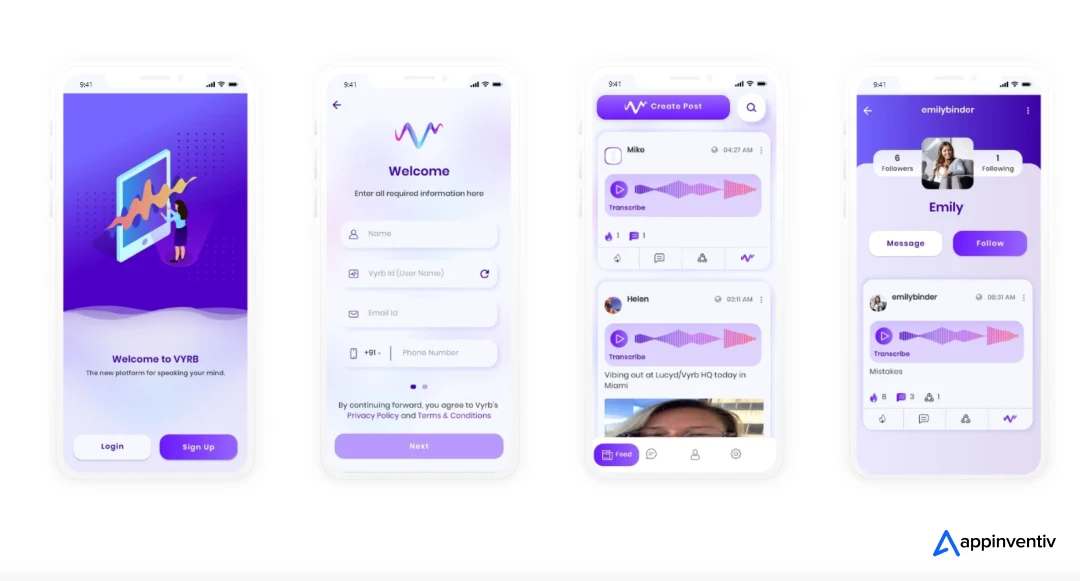
- Tootle – We developed Tootle, an AI-powered application that provides instant answers to general queries about a location and facts, not just by text, but also by speech.
- HouseEazy — Our AI developers created a property discovery platform that automates lead qualification and price prediction. It uses key parameters like location, bedroom/bathroom count, and property features to match buyers with the most relevant listings.
Contact us now or hire artificial intelligence model developers to build an AI model for your enterprise that elevates growth, innovation, efficiency, and your digital transformation journey.
FAQs
Q. What is the impact of AI on enterprises?
A. The impact of AI on enterprises is wide-ranging and significant:
Enhanced Customer Experience: AI enables personalized interactions by delivering tailored recommendations and responsive support. This significantly improves customer satisfaction and engagement.
- Increased Productivity: AI automates monotonous processes, streamlining operations and freeing up human resources for strategic actions.
- Making Informed Decisions: AI analyzes enormous data sets to provide insights that help people make precise, data-driven decisions about many different business-related issues.
- Predictive Analytics: AI can identify trends and use that information to better allocate resources, manage inventories, and plan ahead.
- Innovation: As a result of patterns and opportunities that AI identifies, business can create new strategies, products, and services.
Q. How does an intelligent AI model work for enterprises?
A. An intelligent AI model for enterprises analyzes various data sets using cutting-edge algorithms and enterprise machine learning models. It learns from historical data trends, correlations, and insights throughout training. After training, it is incorporated into business operations, automating processes, forecasting results, and making data-driven suggestions. By ensuring accuracy and relevance through ongoing monitoring and feedback, numerous enterprise areas can benefit from wiser decisions, improved processes, and innovation.
Q. How to create your own AI models?
A. When looking to create AI models, you need to follow a series of strategic steps. Here is a concise roadmap that will help you get the answer to how to develop an AI model:
- Define the problem
- Gather and preprocess data
- Select the appropriate algorithm
- Train the model
- Evaluate and fine-tune the model
- Test the model
- Deploy the model
- Monitor and maintain the model
To gain an in-depth understanding of how to build an AI model or what are the key steps involved in building an intelligent AI model for my enterprise, please refer to the above blog.
Q. How do enterprises build intelligent AI systems?
A. Enterprises build intelligent AI systems by identifying business challenges, collecting and processing relevant data, selecting appropriate algorithms, training models, integrating AI with existing systems, and continuously monitoring and optimizing performance.
Q. What are the best tools and platforms for developing AI models at an enterprise level?
A.Popular tools and platforms for enterprise AI model development include TensorFlow, PyTorch, Microsoft Azure AI, Google Cloud AI, and Amazon SageMaker. These are the ideal tech stack that satisfies your queries about how enterprises build intelligent AI systems.
Q. What is the AI model development process for businesses?
A. An AI model is a computational framework designed to learn patterns from data and make predictions or decisions based on that learning. It uses algorithms and mathematical structures to analyze input data, recognize patterns, and generate outputs.
AI models can be trained on various types of data, including text, images, and numerical values, to perform tasks such as classification, regression, clustering, and more.
Q. What are some common types of AI models?
A. Some of the different AI models you can consider developing are:
- Logistic regression AI model
- Linear regression model
- Decision trees AI model
- Deep learning Models
- Generative AI Models
- Random forest model
- K-nearest neighbor model
- Naive Bayes model
These are some different AI models you can opt for when considering how to create an AI model.


- In just 2 mins you will get a response
- Your idea is 100% protected by our Non Disclosure Agreement.

AI Governance Consulting: How to Build Guardrails, Observability, and Responsible AI Pipelines
Key takeaways: Enterprises can no longer rely on principles alone; AI governance must be built into pipelines, model workflows, and decision systems from day one. Strong guardrails across training, inference, retrieval, and agentic actions reduce risks like hallucinations, data leakage, and prompt injection. AI observability is central to governance, giving leaders real-time visibility into drift,…

How to Build a Custom Multilingual Chatbot? Features, Process, Costs
Key takeaways: Multilingual Chatbots Drive Revenue Growth: Companies see higher conversion rates when customers can interact in their native language, with nearly 75% of global customers preferring to buy from websites in their preferred language. Beyond Translation to Cultural Intelligence: Successful implementations require cultural adaptation, not just language translation. Systems must understand context, emotion, and…

How Much Does It Cost to Build an AI App in Dubai?
Key takeaways: AI app costs in Dubai typically range from AED 80,000 for simple builds to AED 800,000+ for enterprise systems. Dubai is past AI experimentation, and not investing now means catching up later at higher cost. The real budget is driven by data, integrations, architecture, and compliance, not just app features. Hidden costs like…
